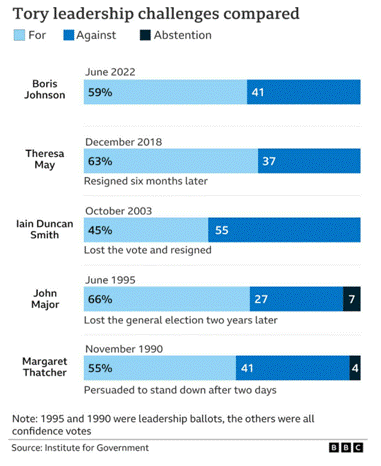
Certainly Uncertain: Factors Driving the Euro in the Coming Months
13 June 2022
False signals: has the Fed damaged its credibility?
21 June 2022INSIGHT • 14 JUNE 2022
What’s Driving the Pound?

Marc Cogliatti, Principal, Global Capital Markets

Nevertheless, Boris has shown remarkable resilience during his tenure so far and for what it’s worth, the betting markets are suggesting a 27% probability of him leaving his post before the end of 2022, a 31% chance of his departure during 2023 and 42% on him remaining in office into 2024.
What does it mean for the outlook for sterling?
Intuitively, it feels highly unlikely that any sort of political uncertainty could be a positive for the pound. So, the question is, how negative could it be? In part, the answer will be dependent on what a change entails. Another Tory leader seems unlikely to be game changer. It may help unite the party in the short term but ultimately, it seems unlikely that we’ll see a dramatic shift in policy. A general election resulting in a change in government would likely be more negative, but as highlighted above, a Starmer led Labour Government is a far cry from how things might have looked under his predecessor.
For now, the greater determinant of sterling’s fate is the outlook for monetary policy and inflation relative to its peers. Given the Bank of England’s independence, a change in government shouldn’t really impact the outlook for monetary policy unless of course, it results in a significant change in fiscal policy.
Instead, the challenge facing the central bank is whether to risk tipping the economy into recession in an attempt to prevent prices spiralling further out of control. Yesterday’s GDP print showed the UK economy contracting 0.3% in April (vs expectations of +0.1%) with declines in services, construction and both manufacturing and industrial production. However, with headline inflation currently running at 9% (and expected to rise above 10% in the months ahead) there appears little scope for the MPC to take their foot off the gas when it comes to tightening monetary policy. The fact that real rates (adjusted for inflation) remain lower in the UK than they do for either the US or EU, doesn’t bode well for sterling.
A final point to note and a particularly important factor influencing sterling in the short term is the impact of risk sentiment. History tells us that sterling has a tendency to under-perform when markets are in ‘risk-off’ mode so with the S&P 500 now officially in bear market territory (i.e. 20% below its recent peak) there is a risk that sterling remains under pressure in the near term, particularly against the safe haven dollar.
Be the first to know
Subscribe to our newsletter to receive exclusive Validus Insights and industry updates.


